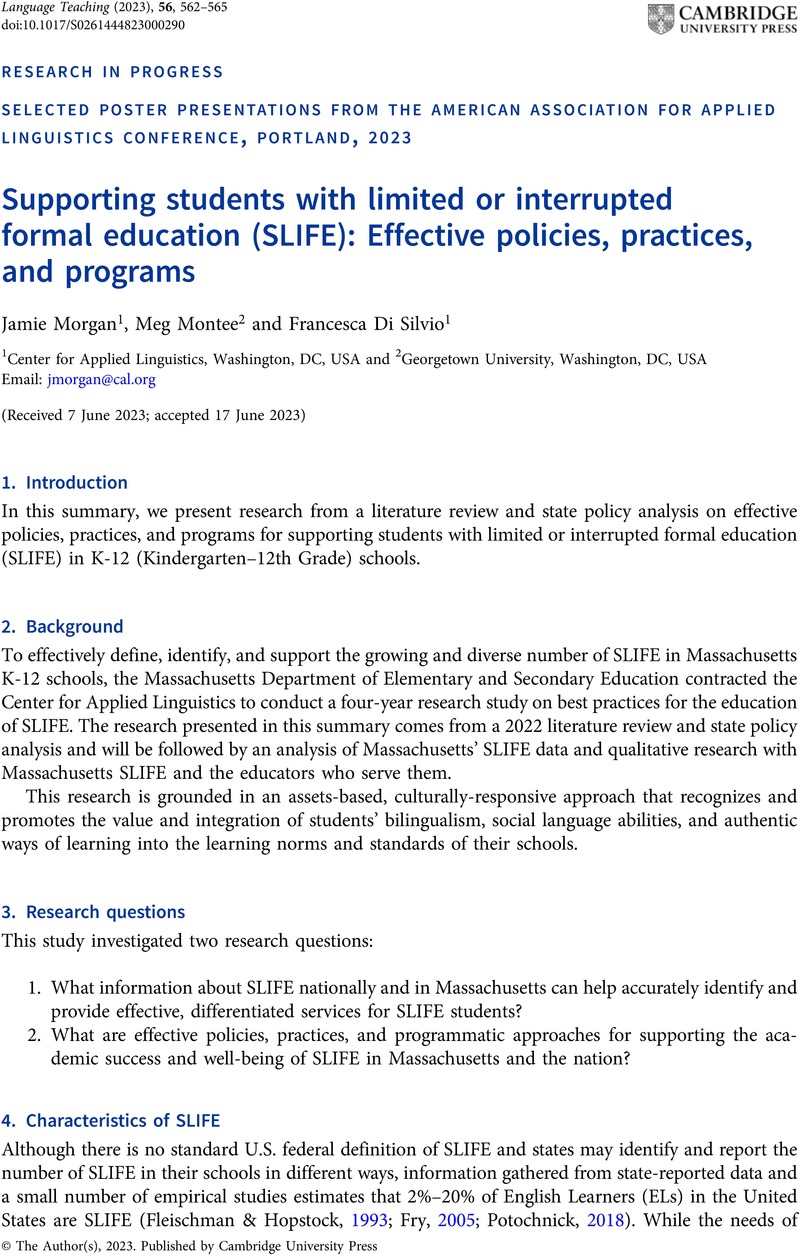No CrossRef data available.
Article contents
Supporting students with limited or interrupted formal education (SLIFE): Effective policies, practices, and programs
Published online by Cambridge University Press: 28 July 2023
Abstract
An abstract is not available for this content so a preview has been provided. Please use the Get access link above for information on how to access this content.

- Type
- Research in Progress
- Information
- Copyright
- Copyright © The Author(s), 2023. Published by Cambridge University Press
References
Bajaj, M., & Suresh, S. (2018). The “warm embrace” of a newcomer school for immigrant & refugee youth. Theory into Practice, 57(2), 91–98. https://doi.org/10.1080/00405841.2018.1425815CrossRefGoogle Scholar
Barba, Y. C., Newcombe, A., Ruiz, R., & Cordero, N. (2019). Building bridges for new immigrant students through asset-based consultation. Contemporary School Psychology, 23, 31–46. https://doi.org/10.1007/s40688-018-00212-1CrossRefGoogle Scholar
Cohan, A., & Honigsfeld, A. (2017). Students with interrupted formal education (SIFEs): Actionable practices. NABE Journal of Research and Practice, 8(1), 166–175. https://doi.org/10.1080/26390043.2017.12067802CrossRefGoogle Scholar
DeCapua, A., & Marshall, H. W. (2010). Serving ELLs with limited or interrupted education: Intervention that works. TESOL Journal, 1(1), 49–70. https://doi.org/10.5054/tj.2010.214878CrossRefGoogle Scholar
DeCapua, A., & Marshall, H. W. (2011). Breaking new ground: Teaching students with limited or interrupted formal education in U.S. Secondary schools. University of Michigan Press.CrossRefGoogle Scholar
DeCapua, A., Marshall, H. W., & Tang, L. F. (2020). Meeting the needs of SLIFE: A guide for educators (2nd ed.). University of Michigan Press.CrossRefGoogle Scholar
Drake, K. (2017). Competing purposes of education: The case of underschooled immigrant students. Journal of Educational Change, 18, 337–363. https://doi.org/10.1007/s10833-017-9302-3CrossRefGoogle Scholar
Fleischman, H. L., & Hopstock, P. J. (1993). Descriptive study of services to limited English proficiency students. Development Associates.Google Scholar
Flores, E. (2022). Students with interrupted formal education: Empowerment, positionality, and equity in alternative schools. TESOL Journal, 13(1), 1–16. https://doi.org/10.1002/tesj.602CrossRefGoogle Scholar
Fry, R. (2005). The higher dropout rate of foreign-born teens: The role of schooling abroad. Pew Hispanic Center. Retrieved from https://www.pewresearch.org/hispanic/2005/11/01/the-higher-drop-out-rate-of-foreign-born-teens/Google Scholar
Hos, R. (2020). The lives, aspirations, and needs of refugee and immigrant students with interrupted formal education (SIFE) in a secondary newcomer program. Urban Education, 55(7), 1021–1044. https://doi.org/10.1177/0042085916666932CrossRefGoogle Scholar
Hos, R., Murray-Johnson, K., & Correia, A. (2019). Cultivating capital for high school newcomers: A case study of an urban newcomer classroom. Journal of Ethnic and Cultural Studies, 6(1), 101–116. https://doi.org/10.1080/26390043.2017.12067802CrossRefGoogle Scholar
Olivares-Orellana, E. (2020). More than an English language learner: Testimonios of immigrant high school students. Bilingual Research Journal, 43(1), 71–91. https://doi.org/10.1080/15235882.2019.1711463CrossRefGoogle Scholar
Potochnick, S. (2018). The academic adaptation of immigrant students with interrupted schooling. American Educational Research Journal, 55(4), 859–892. https://doi.org/10.3102/0002831218761026CrossRefGoogle Scholar



